So Camden Cyclists admit that Royal College Street isn’t “truly Dutch” (though they still claim it has “gone Dutch”).
They now suggest that the street is in fact a mix of Spanish, Canadian and Danish cycling infrastructure styles. But they do also claim one ingredient from our neighbour to the east: “The lane widths conform to Dutch CROW standards.”
They are wrong to claim this, and I’ll explain why.
Looking at the new design, the cycle lanes do look pretty generous. Two whole metres wide! (That’s a bare minimum for new Dutch infrastructure.) So the width ain’t bad.
It’s certainly far wider than what Tower Hamlets considers suitable which is so bad it ridicules itself. (I wonder if any one in Tower Hamlets council described that as Dutch?)
Never mind the quality, feel the width
In cross-section, it would look something like this (not to scale):
But there’s a problem, and it’s a biggie: you can’t actually use the whole track.
The issue is that the kerbs are steep and high – higher than your pedal at its’ lowest point. Ride too close and the pedal will whack the kerb, either on the side or on the top, and that won’t be nice.
As a result, it’s just too dangerous to ride close to the kerb, so people tend to ride further out towards the middle of the lane.
Because of this, there’s not that much room to overtake or ride side-by-side comfortably. It can be done, but you’ve got to keep your wits about you (to coin a phrase) and be careful not to wobble.
As the diagram above shows, the full width isn’t actually available to ride in. Get too close to either edge and your pedal will strike the kerb or the planter. Naturally, the closer to the edge one rides, the less comfortable one feels.
While I was watching people ride along the new track, overtaking mainly happened while passing the armadillos – the overtaker can get close to them without hitting their pedal on a planter.
I also witnessed people leaving the bike lane to overtake other riders, then rejoining once they’d passed by. (Surely this is proof that there’s not enough space?)
So overtaking a single rider is possible, but it can be a little uncomfortable as there’s not much room for error.
It ain’t what you got, it’s what you do with it that counts
For full use of the available width, it would look something like this, and I want you to bear in mind that the width of the riding surface is exactly the same as in the other diagrams above:
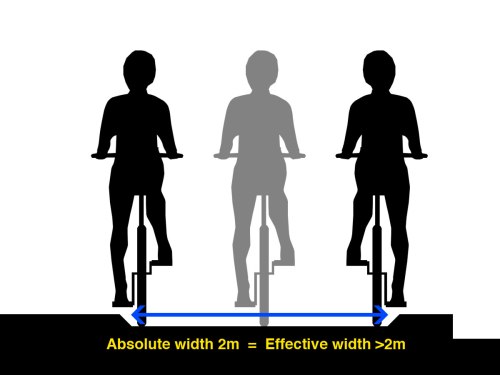
The entire width of the track can be used. Remember, the width of the surface is exactly the same as in the other diagrams above.
Here, the cycle lane (or rather, cycle path, or – even better – cycleway) has been raised up halfway between the road and the path (or, to use more technical language, halfway between the carriageway and the footway), so the footway is about 75mm higher than the cycleway (this is known as the upstand). Also note the ~30º angled “forgiving” or “splay” kerbs, which are safe to ride against, as the wheel is gently nudged back into the cycleway.
Now the full width of the track can be used – even better, as it’s safe to ride right up to the forgiving kerbs, pedals and handlebars can extend beyond the width of the cycle path, which means that the effective width is even wider. (This requires the footway to be wide enough for the comfort of people walking, and for the separation on the carriageway-side to be wide enough, too. I’ve not shown this in the diagram above.)
My diagrams may not be to scale with the outside world, but they are to scale with each other, and the Dutch-style cycle path clearly has far more capacity than the Royal College Street examples – even though the width of the surface, from edge to edge, is exactly the same width in all four diagrams.
That “Dutch CROW standard” 2 metres (which, by the way, should be a minimum, not a target) isn’t being used to its full potential at Royal College Street – indeed, it can’t physically be used by the people who ride along it – and the experience of riding on a proper Dutch cycle path of exactly the same actual width would be quite different.
North vs South
I’ve only covered the northbound lane here. The southbound lane is even more tricky, as the right-hand barrier is a row of cars, so you can’t just leave the cycle lane for a few seconds and then rejoin. The discomfort zone is also very wide due to the risk of dooring. I’m going to cover this in another post, but for now, how would you overtake this rider if they were a little further back up the hill?

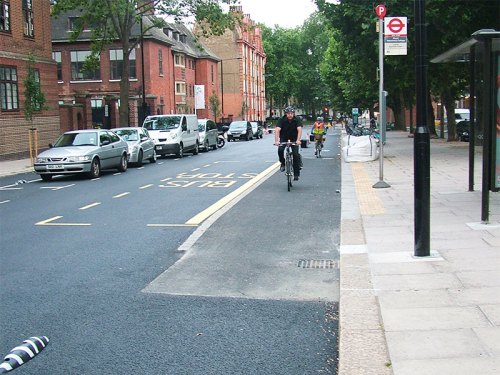

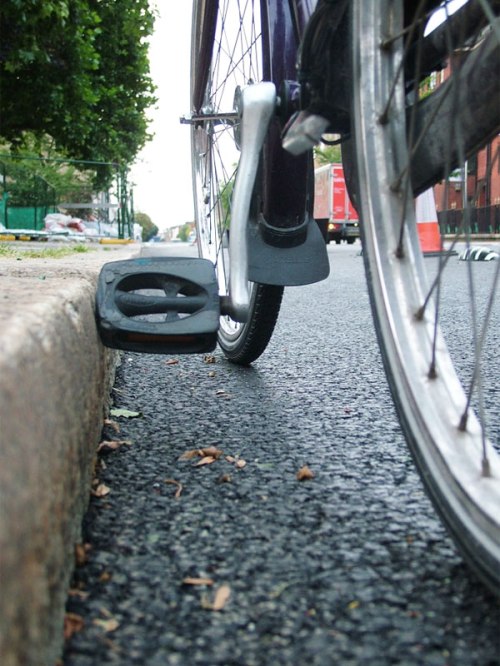
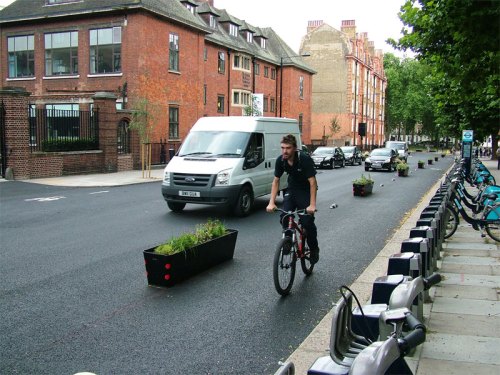
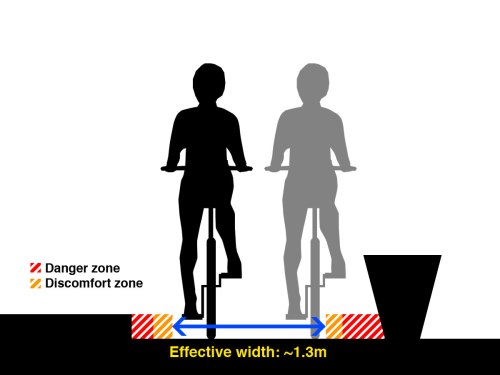
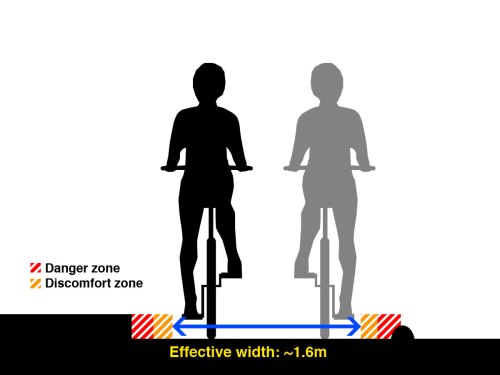
 The Alternative Department for Transport is written by, and the personal opinion of,
The Alternative Department for Transport is written by, and the personal opinion of, 



Bloody brilliant post – you have a real knack for dissecting design and explaining it in simple, clear, visual terms. I wish I had half your skill!
What I can’t believe is that they can get away with planters on the highway. Any other item of street furniture is usually located at least 450mm back from the kerb so it can’t be clipped by passing traffic (bikes or motor vehicles). I would have thought that this design is just asking for damage / personal injury claims. The ambulance chasers must be rubbing their hands with anticipation!
Aw shucks! I was worrying for ages that it wasn’t clear, too. Thanks!
As for the planters, it seems that when it comes to cycling infra we can try out all kinds of zany new things, more exotic the better. Armadillos from Spain? ¡Place an order, amigo! Planters from Vancouver? Why the hell not, eh!
But when it comes to proper infra (i.e. that which is made for cars) we’ll stick to what we know, thank you very much. I guess the planters have fallen into the gap here – crazy bike experiment, rubbing up against the real provision. It will be interesting to see how well they fare. One of them has already taken a knock.
I suspect they’ll paint a buffer zone or something, should they cause a problem.
Vancouver has the right idea about putting the planters on a median dividing cyclists from motor traffic. Heck they’re so civilised that they even installed a protected intersection and is working on the design for another.
Ha ha! Recovered from the Twitter debate and flu then? 🙂 Excellent. This gives me the opportunity to continue my whinges. I’m not too bothered about the Dutch or not-Dutch bit, except a) as Mark Wagenbuur pointed out, it is now less Dutch than it was, and b) it’s just symptomatic of slack standards calling it Dutch when it plainly isn’t.
Obviously I support your criticism of the bus stops, and the bounding issues you highlight hare also seem perfectly valid. Sorry if this is not adressing the detail of your post, but I have 2 other, general points to make: firstly that any criticism is unwarranted and secondly on what is perceived to “work”. They do rely on your findings though.
It was suggested on Twitter that criticism was a bit OTT because there have been few problems in 13 years. That is not the point – why NOT include bus passenger friendly elements when you have the opportunity and the means. It’s a bit like not putting wheelchair ramps on new builds with the excuse that not many wheelchairs are expected, or, as will resonate wth cyclists, saying there’s no need for paths on, say, a dual carrageway because there aren’t many cyclists. But it’s also a question of building for subjective safety (for bus passengers and pedestrians in this stop case – for cyclists in terms of the “boundary condiitons” of your current post). So I think details such as the design of bus stops and lane boundaries are important – they show how much thought is being given to subjective safety for all users – you build to cater for the most vulnerable first and you pay special attention to the points of most likely conflict, whether or not they are an issue now.
In the debate, I kept reading the phrase, “as long as it works” and was given assurances that new RCS “works’. Now call me a pedant, but I don’t define “works” as “I like it”. The new design has simply not gone on enough to assess whether it “works” or not, using quantitative metrics of safety and/or increase in users. Indeed, your current post suggets that problems are already cropping up due to the change in design. However given that RCS is one of the least accident prone streets in the area on the ito map, it is bound to “work” in safety terms. The old quasi-Dutch-style paths seem to have done, so when campaigners pointed out there was a safety problem with the junction with Plender St. (there also seems to be one at Platt St) one is entitled to ask why not just modify those junctions instead of messing about with the whole road.
So I expect you and Mark Wagenbuur (among others) as well as myself are all on tenterhooks waiitng for David Arditti’s promised explanation for why the change from quasi-Dutch to less Dutch has been so good, or indeed, necessary.
Just about recovered, thank 🙂
I agree with what you’re saying here – the opportunity was there to do it much better, the space is there too, so it should have been done. Using the excuse “well we’ve had no collisions” isn’t good enough. How do we know there aren’t people getting off a stop early, or even avoiding that bus route altogether, because they feel vulnerable getting off the bus?
Apparently Camden felt they’d tried everything they could at the junctions, but I never once saw a harsh speed bump (just a mild “speed table”) – you know, the type which you can’t go over fast because they’re so short and steep? But I can see how the two-way nature of the old track could cause drivers to pull out at a bad time. I wonder if they ever considered closing Plender St and Platt St? Or making them entry-only from Royal College Street? Anyway, that’s all moot now, as the old track is gone!
I don’t hate the new Royal College Street, I have no grudge against it. But I do think there was a danger of it being touted as “Dutch” when it isn’t (especially the bus stops) and it needs the bad points criticising. There’s more to come!
You should get together with a few other people and start an independent certification service for cycling infrastructure. With some swank name and some real PR that might take off and effectively provide the standards that ought to exist but don’t.
I quite like the idea of grading things A to E (with an F or U for fail), like at school. Perhaps I need to create some marking guidelines?
How can they even call it Dutch when it doesn’t look Dutch? To put it nicely, I’d say it was ‘inspired’ by Danish infrastructure, though with none of the attention to detail.
Pingback: Armadillos: The Emperor’s New Infrastructure | The Alternative Department for Transport